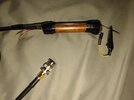A while back I built an active probe for my oscope and fc, but I had no electronic flux. I figured I could get away with using plumbers flux as long as i washed it off really well. I used acetone, water, acetone again with a fine paint brush trying to get under the parts the best I could. It looked good and worked good, for a while. it didn't work today, so I pulled it out of its copper pipe. This is what happens when the solvent traps a little flux under the part. The solvent migrates to the surface where it evaporates depositing the zinc chloride over everything.

Now I need to decide if these heat gun victims go back in, or new ones.

Now I need to decide if these heat gun victims go back in, or new ones.

